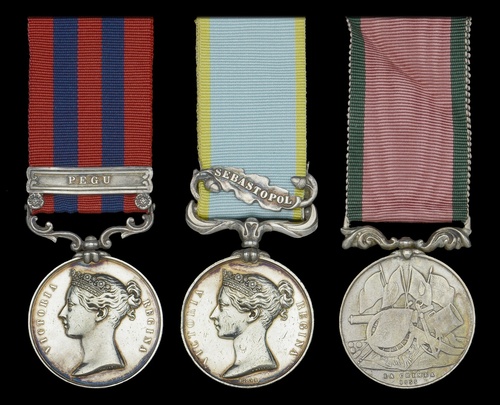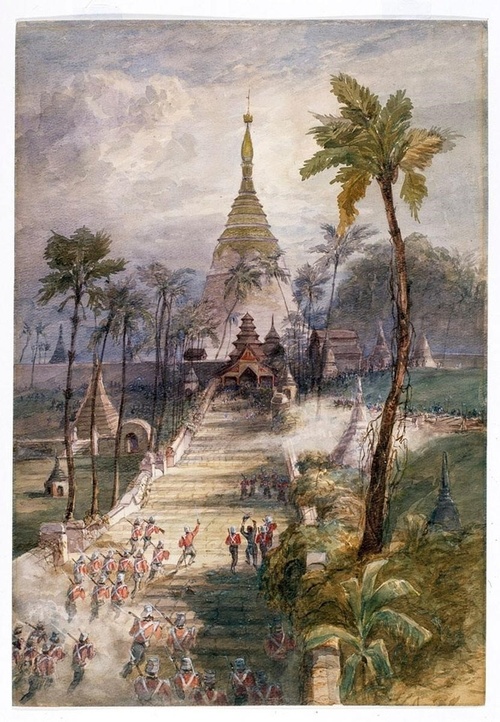Auction: 25001 - Orders, Decorations and Medals
Lot: 53
(x) Three: Major C. F. Kelly, 18th Royal Irish Regiment, whose regiment saw heavy fighting during the famous storming of the Shwe-Dagon Pagoda and during the Crimean War
He was present for the storming of the Redan during which men of the 18th actually breached Sebastopol's defences in an action which won Captain Esmonde the Victoria Cross
India General Service 1854-95, 1 clasp, Pegu (Lieut. Chas. Fredk. Kelly. 18th. Royal Irish Regt.); Crimea 1854-56, 1 clasp, Sebastopol (Chas. Fredk. Kelly. Capt. 18th. Rl. Irish Regt.) contemporarily engraved naming; Turkish Crimea 1855, Sardinian issue, unnamed as issue, plugged and fitted with an IGS-style suspension bar, edge bruising and light contact marks, very fine (3)
Provenance:
Dix Noonan Webb, September 2006.
Charles Frederick Kelly was commissioned an Ensign in the 18th Regiment on 2 April 1843 and was promoted Lieutenant on 5 February 1847. He served with the regiment in the expedition under General D'Aguilar in April 1847 and was soon to see hot action during the Second Burma War. The unit went into battle for the first time on 5 April at Martaban when they were the first to storm the wall under over of the bombardment. Captain Gillespie is noted as the first in, with the Grenadier Companies and the 80th Regiment in the thick of the action too.
Having secured Moulmein, they were again engaged at Rangoon when they assisted the Bengal Sappers and the Bluejackets getting through the thick jungle to bring their ladders onto the White House stockade. On 14 April they were faced with the magnificent Shwe-Dagon pagoda. A fiercely protected bastion, the spectacular 14th century pagoda was defended by cannon over its three main tiers, in addition to being protected by a brick and mud rampart. The force chosen to storm the Pagoda comprised a detachment of the 80th, two Companies of the 18th (Royal Irish) Regiment and some troops from 40th Bombay Native Infantry. An approach march having been made before dawn through jungle, the ranks of the storming party readied themselves for the attack. James Jones's History of the South Staffordshire Regiment (1705-1923) takes up the story:
'The distance to be covered in the advance to the eastern entrance of the Pagoda was 800 yards. The troops crossed steadily under a heavy fire from the walls crowded with the enemy. When the storming party reached the Pagoda steps, a rush was made for the upper terrace, and a deafening cheer told that the Pagoda was won. The enemy evacuated the place in great confusion, and were severely handled by the troops and the fire from the steamers on the river.
They latterly found themselves under siege at Prome in August-October 1852 and in November two Companies were sent out to the districts on patrol to locate enemy. With a force cornered at Tomah, the British waited until March 1853 for reinforcements for a full scale attack, which eventually cost the 18th 1 killed and 28 wounded. The Regiment sent Companies onto the Tonghoo Pass to shepherd a delivery of 148 elephants over the pass. Others were sent out against Myat Toon and were part of the main attack on his stronghold on 19 March, when a frontal attack with the Sikhs secured the victory. Once peace stopped the field operations, the unit was returned to Calcutta, depleted by 365 casualties over the course of the operations.'
Promoted to Captain on 4 August 1854 Kelly was to serve at Sebastopol from December 1854. Whilst there the Regiment took part in the first storming of the Redan on 18 June 1855 after a heavy bombardment the night before. Unfortunately the famous Russian engineer, Totleben, was able to repair the damage during the night which- combined with a number of mis-communications between the allies- saw the attack repulsed. In the course of this the Royal Irish suffered losses of 259 killed and wounded.
Part of the reason for such high losses was their surprise success, breaking through into Sebastopol itself, the famous War Correspondent William Russell noted:
'The moment the enemy retreated, their batteries opened a heavy fire on the place from the left of the Redan and from the Barrack battery. Four companies of the XVIIIth at once rushed out of the cemetery towards the town, and actually succeeded in getting possession of the suburb. Captain Hayman was gallantry leading on his company when he was shot through the knee. Captain Esmonde followed, and the men, once established, prepared to defend the houses they occupied.'
For his gallantry Esmonde was awarded the Victoria Cross, the Regiment however had still been decimated in the fighting. Kelly was advanced Major on 14 December 1860; sold together with copied research.
Subject to 5% tax on Hammer Price in addition to 20% VAT on Buyer’s Premium.
Estimate
£700 to £900
Starting price
£550







